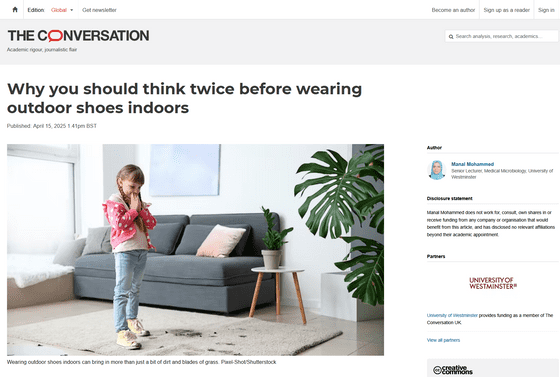Foreign experts praise the custom of taking off your shoes at the entrance as a great custom, but what are the serious risks of entering a house with shoes on?

by
In some countries overseas, such as the United States and Canada, where the grounds and entrances are spacious, and in Scandinavian countries where people need to keep their feet warm due to the cold climate, it is common to have a ' shoe-wearing culture ' where people do not take off their shoes when entering a house. Public health experts have argued that the habit of taking off footwear indoors, which is common for most Japanese people, is 'a wise and essential habit that can protect you from serious, invisible health threats.'
Why you should think twice before wearing outdoor shoes indoors
https://theconversation.com/why-you-should-think-twice-before-wearing-outdoor-shoes-indoors-254427

'My mother had a strict rule that no outdoor shoes were to be worn inside the house, and anyone, whether it was family, neighbours or guests, would always have their shoes removed before passing through the front door,' says Manal Mohammed, a senior lecturer in medical microbiology at the University of Westminster in the UK.
As a child, Mohammed felt that his mother's rule was a strange obsession, but as an adult he came to understand that it was for health and safety and to keep living spaces hygienic. And a growing body of scientific evidence also suggests that the habit of taking off your shoes has significant hygienic benefits.

When people think about the unsanitary nature of wearing shoes indoors, they often focus on visible dirt such as mud and dead leaves, but scientifically speaking, invisible threats such as bacteria, allergens, and harmful chemicals like herbicides and pesticides are more important.
For example, data from
While some strains of E. coli are harmless, others produce Shiga toxins that cause bloody diarrhea and hemolytic uremic syndrome, a fatal disease that can lead to kidney failure and is particularly dangerous for children under the age of 5, whose immune systems are immature and who frequently put their hands to their mouths.
Bacteria aren't the only health risk associated with shoes: studies have shown that outdoor shoes can carry pesticides, herbicides, and heavy metals, including lead, which pose a serious health threat, especially to young children who spend time close to the floor, and to pets who lick their paws while grooming.

Lead can stunt brain development in children, causing lifelong cognitive impairment, pollen and other allergens can worsen allergies and respiratory illnesses in the safety of our homes, and, Mohammed says, 'particularly worryingly, asphalt sealants contain carcinogenic compounds.'
A US study published in 2016 found that if these chemicals are brought inside the home, they can persist in household dust and reach concentrations 37 times higher than outdoors.
With this mounting evidence, Mohammed reflected, 'My mother used to say, 'A clean house means a clean mind,' and it turns out she was right all along.'
Related Posts:
in Free Member, Science, Posted by log1l_ks







